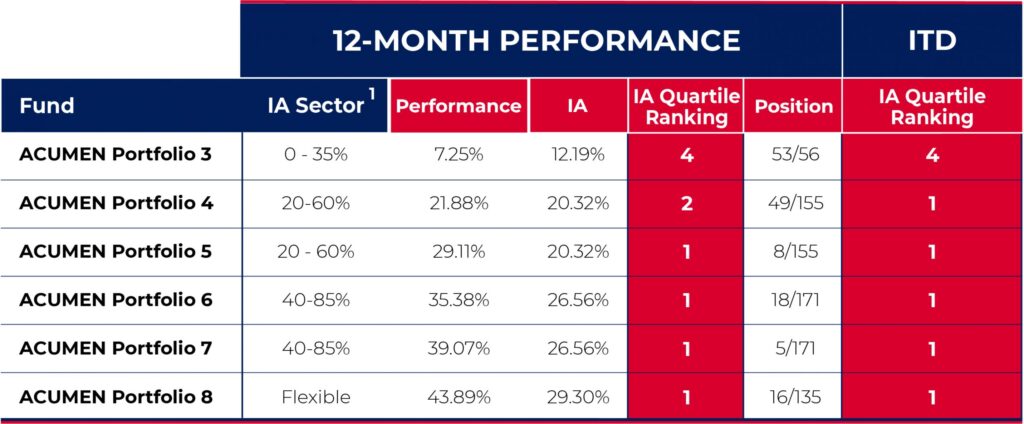Q2 Quarterly perspectives
Tavistock Wealth – Investment Outlook
John Leiper, Andrew Pottie, Sekar Indran, Alex Livingstone, Jonah Levy and James Peel
Welcome to the Q2-2021 ‘Quarterly Perspectives’ publication
12-Month Review
It has been a little over one year since the world went into lockdown. At the time of writing, we seem to be emerging from that hiatus. The intervening period has been one of considerable disruption but also an opportunity for reflection; to take stock, evaluate and improve how we do what we do across the centralised investment proposition. As a result of these changes and the steadfast determination and professionalism of the investment team we were able to deliver strong risk-adjusted returns during a period of considerable uncertainty and market volatility. Relative to the peer group, all but one of the ACUMEN Portfolios significantly outperformed their respective IA sector, with some of the funds making the top 10. This strong performance also bolstered our inception-to-date rankings where 5 of the funds now appear in the first quartile.

Source: Lipper for Investment Management, Tavistock Wealth Limited
Footnotes:
1. The IA Sectors have been updated to reflect the most appropriate sector subject to internal (Tavistock Wealth & IFSL) and external (FCA) review.
Key Themes
Crises rarely occur in isolation. Once the history books are written they typically signify, catalyse, or help forge, broader structural change. From that perspective, we think the coronavirus pandemic marks a potential turning point in the secular cycle, a break with the old neoliberal economic order and the start of a new chapter characterised by the greatest economic boom in recent times.
At the heart of the neoliberal agenda sit three core themes. The first is the retreat of social democracy. The stagflation of the 1970s was blamed on mismanagement of the economy, itself the result of an abundance of democracy and ill-equipped, inexperienced politicians overly focused on the short-term political cycle. The answer that emerged was the transference of power to an elite group of highly educated and politically insulated technocrats, the central bankers. These would be the true shepherds of the future economy. The second core theme is the power of the free-market, which would result in the most efficient allocation of resources and in turn drive faster economic growth. This free-market approach to capitalism is consistent with deregulation, a reduction in government spending and the dominant role played by capital markets throughout the 1980s and ensuing decades. The third and final theme, which follows-on from the prior two, is the overwhelming focus, amongst central bankers, on taming and controlling inflation. This focus was born out of the painful and costly experience of the 1970s. Over the last few decades, and in-spite-of the complete absence of above-target inflation, the Fed has pre-emptively hiked interest rates, imposing a consistent downward bias, which has proven a boon to financial markets over the years.
Each of these three themes are increasingly under threat. We can see the reason for this by focusing on the core failure of neoliberal policy… widening inequality to the detriment of the working class.
Whilst gains in productivity were broadly shared before 1980, the average US worker has since failed to participate, contributing to a remarkable separation between a productivity index of hourly output and the median family income adjusted for inflation. The chart shows profits climbed faster than wages with higher earners capturing a greater portion that lower-paid employees, contributing to a notable rise in income inequality over the years.
Growing inequality has contributed to the rise of political populism across the globe. As a result, the desire to hand control back to the politicians, began to build momentum. In the US, the most obvious example is Donald Trump whose anti-elitist rhetoric spoke to those that had been left behind.

Source: Bloomberg, Tavistock Wealth Limited
Signs of a shift in American politics also emerged under Bernie Sanders and his focus on working-class values. Bernie’s radical persona failed to appeal to the democratic vote but the ideas that emerged from his movement remain at the forefront of Democratic party policy today under Biden. After winning the Georgia state run-offs, the Democrats are in the enviable position of controlling federal policy. They will not make the same mistake they made in 2010 and to win the mid-terms, and retain control of Congress, they know they need to go all-in, guns blazing… with a $1.9 trillion spending package.
Economic power is being wrestled back, from the technocrats to the politicians, who seek to usher in a new age of fiscal dominance characterised by increased government spending. This has coincided with the rise of a new intellectual discipline called MMT, or modern monetary theory, which in simple terms states governments should use fiscal policy to achieve full employment and do so by creating new money to fund purchases.
This should be the point for the technocrats to push back. Leading the charge was Larry Summers, who served as US Treasury Secretary for Bill Clinton. He argued Biden’s economic stimulus package risked unleashing the worst inflation in a generation. His article drew forth a rigorous response from critics, who suggested worrying about overheating was ‘foolish in the extreme’, but very little support from his fellow technocrats. This is somewhat surprising but bear in mind that this is all happening at a time when monetary policy seems to have reached the limits of its effectiveness. The Fed’s response to the crisis took interest rates to their lower bound and helped alleviate a major liquidity meltdown. But buying assets, in such huge quantities, not only undermines theme number 2, the free functioning of markets, it also contributes to the inequality problem.
It seems the intellectual conversion of the technocrats may have already taken place and if so, that turning point was probably August last year, when Jerome Powell announced a shift towards average inflation targeting. This means the Fed will now allow inflation to overshoot its official 2% target to compensate for prior years where inflation failed to reach that level. This marks a clear break from theme number 3, and a suitable bookmark to the Paul Volcker years.
To summarise, for all its success, neoliberal economic policy has contributed to widening inequality and a changing political landscape. Economic power is being wrestled back, from the technocrats to the politicians who seek to usher in a new age of fiscal dominance characterised by increased government spending. These developments, which have been turbocharged by the pandemic, undermine the prior neoliberal economic order and seek to replace it with something new. What makes this juncture so interesting is that even as fiscal policy goes into overdrive, monetary policy is likely to remain highly accommodative throughout. To our mind, this points to a period of outsized economic growth and higher inflation.
Chart of the Quarter
US inflation rose to its highest level in almost three years in March, to 2.6%. This is consistent with rising commodity prices and rising input cost inflation, as shown by the US Empire State Manufacturing Survey Prices Paid index in blue. The sharp rise in inflation will not stop here as we are now approaching a three-month run where decade-low monthly readings drop out of the rolling calculation. The real question remains to what extent these figures prove transitory, as the Fed expects, or something longer lasting. We won’t know that until later this year when rising inflation expectations and the release of pent-up demand offset declining base rate effects.
These key themes are the common thread running through this Quarterly Perspectives document, which forms the basis of our strategic investment outlook. Over the last few months we have taken steps to implement these views, on a tactical basis, across the ACUMEN Portfolios. Specifically, we have leaned further into the re-opening narrative by adding additional positions to our cyclical exposure. In equities we remain underweight the US where we prefer exposure to value stocks, particularly via the S&P 500 industrials, financials and materials sectors. Outside the US, we like the UK and recently added new positions in European energy majors and Japanese small cap stocks. Within emerging markets we continue to like Brazilian and Russian equities. To complement our cyclical positioning, we have retained some exposure to those highly profitable companies that we believe also benefit from long-term structural tailwinds. These include Taiwanese semiconductor companies, Chinese Technology firms, and ESG via companies in the clean energy space. In fixed income we favour inflation-linked bonds and high yield debt over investment grade credit with a preference for short-dated securities. We remain underweight long-dated nominal government bonds. Finally, we like commodities which can deliver strong gains over the coming cycle and provide an inflationary hedge and additional diversification benefits.
Asset Allocation Outlook

Fixed Income
Bonds have driven global markets so far this year as the reopening economy and rising inflation expectations change the curvature of the US yield curve. Since the front-end is anchored by easy monetary policy, the inflationary outcomes of Covid-19 are being felt much further along the curve. We believe that inflation, particularly in the US, has further to run. As a result, we remain underweight the longer end of developed market government bond curves, favouring the front end of both nominal and inflation-protected Treasuries instead.
US longer dated Treasuries’ yields have risen far more than those of shorter maturities year-to-date.
We maintain this preference, for shorter duration securities, within our investment grade corporate bond exposure. At the beginning of the year US investment grade yields did not suitably compensate investors in real terms, hence we reduced duration within this exposure. Having increased our outlook on high yield to neutral last quarter we continue to favour our strategic positioning in higher quality sub-investment grade debt. High yield debt historically has lower sensitivity to underlying interest rates and is thus one of the best performing fixed income sectors year-to-date.
US investment grade corporate bonds are more sensitive to changes in US Treasury yields.
Whilst local currency emerging market debt has suffered recently, with a rising US dollar and higher developed market bond yields, we retain our preference for Chinese government bonds. Not only has this position performed well, on a relative basis during periods of market stress, but it should also benefit from an estimated $130bn of inflows following further index inclusion following final approval from the FTSE Russell.
Equities
The narrative of 2020 equity market losers becoming 2021 winners has played out so far this year with the rotation out of growth stocks and into value and cyclicals gaining momentum. We have tactically tilted our portfolios in favour of those segments of the market most geared to the economic recovery.
Our outlook, for a steepening US yield curve, should boost the profitability of financials which have already delivered outsized returns via a notable pick-up in earnings. The resumption of share buybacks, contingent on passing Fed stress tests, will be an additional tailwind for the sector. Optimism around additional fiscal momentum, via the passing of an infrastructure bill, will be another key driver of the reflationary theme with the materials and industrials S&P sectors set to become key beneficiaries. Outside of the US, we recently opened a position in Japanese small caps, which are highly exposed to cyclical sectors of the economy and have scope for price multiple expansion as corporate profits rebound. Within emerging markets, we remain overweight Taiwanese equities amid semiconductor supply shortages given the region’s stronghold in the market.
As equity markets continue to look past the risks surrounding the coronavirus and focus on the reopening of economies, inflation reappears at the centre of investors’ minds. With rising inflation expectations, the direction and dispersion of equity returns will be inextricably linked to not only the level of bond yields but also the rate at which they move.
US cyclicals outperformance vs defensives has been precipitated on rising US 10-year yields.
Taiwanese equities shot out of the 2021 racing blocks.
Commodities
We wrote in our Q1 Quarterly Perspectives on a stronger environment for real assets, amid rising inflation, a weakening dollar, and a phased global re-opening. So far this has rung true; commodities have been the best performing asset class this year, with the S&P Goldman Sachs Commodity Index outperforming the MSCI World by 9.6% year-to-date. Talk of a super-cycle may be premature, but it is evident the economic environment upon which commodities tend to outperform is firmly in place.
We posit cyclical commodities will continue to benefit most acutely, with copper set to outperform (Goldman Sachs price target of $11,000 a ton by year end). We believe that momentary pauses in commodity prices, over the effectiveness of vaccines and localised resurgences of Covid-19, reflect natural periods of consolidation before a second substantial move higher. This is reflected in bullish forecasts from the International Energy Agency who estimate oil demand will increase by 5.7 million barrels per day by the end of 2021, an upward revision of 230,000 barrels. When combined with US inflation rising towards a three-year high in March, oil prices look to have further upside, with WTI having already risen over 20% YTD.
We have implemented these themes through a position in EU oil majors, which are attractively priced relative to their US peers, and Russian equities which are skewed towards energy and financial stocks. We have also initiated a position tracking the Bloomberg roll select commodity index which captures broad-based commodity movements and provides additional exposure to commodity sub-sectors like agriculture. We have continued faith in copper, as the cyclical recovery matched with large scale stimulus plans underpin these higher targets. Our allocation to gold has struggled due to rising bond yields, the pause in dollar weakness and risk-on appetite. However recent central bank buying and consumer demand in Asia has provided price support, and we believe inflation expectations will outpace the rise in nominal treasury yields going forward.
The relative valuations of EU oil majors are cheap in comparison to US counterparts. US majors have moved upwards broadly in-line with the oil price, but European majors have not moved to nearly the same degree. Strong balance sheets, corporate buyback policies and a restarting of production assets should see this correlation rise and the EU majors catch up, compounded by a higher oil price.
Foreign Exchange
The US dollar regained its crown as the top performing currency last quarter against the optimistic backdrop of a resurgent US economy and rising Treasury yields. Yet the resurrection of the dollar comes despite growing concern for the expanding twin deficits and the longer-term fiscal outlook for the world’s reserve currency. We believe this will start to drag on the dollar in the coming quarters as broad-based economic recovery picks-up pace and short-term catalysts give way to longer term structural drivers.
With the global pandemic impairing basic economic functionality so severely in recent times, traders have looked to vaccination rates for an indication on which economies will return to normality first. The UK has been leading the pack in these metrics allowing the UK pound to catch a bid. With the BOE ruling out talk of negative rates, the pound looks set to continue its appreciation against the US dollar, towards purchasing power parity and historical averages, in the 1.40-1.45 range. Meanwhile, the euro has lagged its G10 counterparts in 2021, being behind the curve on vaccinations and suffering from extended lockdowns. If the reopening narrative plays out, this characteristically cyclical currency could well outperform.
Over the long term, the twin deficits should put downward pressure on the US dollar, but for now these structural issues will likely remain secondary to the pace of vaccinations and Biden’s stimulus package.
ESG Investing
In recent surveys of investor sentiment conducted by Bank of America Securities, participants have pointed to ‘Long ESG’ as one of several crowded trades worthy of concern. There are certainly pockets of overvaluation within the ESG ecosystem but as we explained in our Q1 Quarterly Perspectives, ESG-linked assets can be broken down into 3 distinct categories, each with a different value proposition. The ‘adjusters’, or those that can be identified by their high ESG ratings, usually form the core of an ESG strategy and can be seen as a ‘better’ beta of sorts for the ESG ecosystem. Researchers at the NYU Stern Centre for Sustainable Business recently published a broad meta-analysis reviewing the relationship between this category of ESG and investment performance and found there to be a negative relationship between the variables just 14% of the time. Our own research comparing this ‘better’ beta to a vanilla basket found there to be small but persistent outperformance most of time, including through 2020. If there are pockets of overvaluation, the ‘adjusters’ is not the right place to look. The second category, ‘innovators’, includes the smaller component suppliers and technology providers at the cutting edge of the transition to a more sustainability-minded planet. A quick look at the price multiples and significant rerating in 2020 of many of these ‘innovators’ suggests the problem of overvaluation can be isolated somewhere here. The relevant question to ask is whether recent performance was a tsunami, a one-off amalgamation of unwarranted enthusiasm, or the first of several ‘waves’ of strong performance for the companies that fit into this category. We think the latter explanation is more likely. Per the accompanying chart, the rerating in 2020 was isolated specifically in the clean energy, electric vehicle and battery technology sectors. That suggests that there are still attractive opportunities elsewhere in this category as well as the third category of ESG-linked assets, the ‘enablers’. That makes sense, because this transition represents a broad-based, long-term economic opportunity, to the tune of 12 trillion US dollars (according to the landmark Better Business, Better World report published by the Business and Sustainable Development Commission in 2017). A correspondingly broad, long-term investment horizon is necessary to capture the value in each of these successive ‘waves’ of strong performance, the next of which is likely to include companies operating in the water infrastructure, utilities and treatment sectors, and large, incumbent industrials which provide the less glamorous tools and materials needed, for example, to modernise grid infrastructure and improve energy efficiency. We have positioned accordingly.
Clean energy, electric vehicles and battery technology sectors delivered outsized returns last year but have come under pressure in 2021.
Final Thoughts
As detailed in the key themes and subsequent asset class specific sub-sections, we are positioned for a reopening economy. Over the last few months we have taken profit on ‘growth’ and re-allocated towards ‘value’ names, which are attractively priced and stand to benefit the most from the cyclical economic recovery. These trades have performed handsomely within the context of The Great Rotation that has been in place since October.
Rising nominal bond yields have been a key factor driving this equity market rotation. However, with the 10-year Treasury yield having risen from around 1.1% to 1.7% in just a few weeks, we expect a period of consolidation where yields can go sideways for a bit before resuming their upward march. This may result in a partial rebound for growth as demonstrated in the chart below which shows the S&P growth/value ratio moving higher towards a key technical range in yellow. It is not entirely certain why this range has proven so significant, but it is something we continue to watch closely and comes at an important juncture for markets at the start of a new earnings season.
One factor that could help turbo-charge the next leg of the rotation is if we see momentum strategies rebalance into value stocks. The value rally has run long enough that there is an increasing share of value stocks that also screen as momentum stocks. As such, we could see a rare technical event, across momentum strategies, which would trigger a major rebalancing out of tech and healthcare and into financials, energy, materials and industrials… positions we hold across the ACUMEN portfolios.
This investment Blog is published and provided for informational purposes only. The information in the Blog constitutes the author’s own opinions. None of the information contained in the Blog constitutes a recommendation that any particular investment strategy is suitable for any specific person. Source of data: Tavistock Wealth Limited, Bloomberg and Lipper for Investment Management. Date of data: April 2021 unless otherwise stated.





